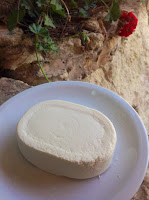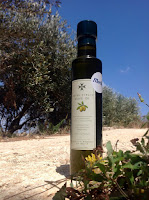NB. This is officially my first recipe on the blog... so please bear with me!
 |
| Local olives are rarely, if ever, found pitted |
6 years ago, when we were still at the initial stages of starting this eco venture, I didn't have the slightest of clues that I'll be concocting dips or preparing recipe blogs! Ok, we were already delving into local products and stuff by then, but me, writing a recipe?! Well it turned out that most of our eco tours ended up having something to do with local food, in some form or another, so it was only a matter of time that we started to explore our own twists to traditional recipes.
For this season's
Olive Grove Experience we introduced home-made dips. We figured that if we're promoting local products we should serve in-house nibbles with fresh ingredients - wherever possible - no shortcuts. Quite simple... yet it took time for us to get there. The supermarket, grab-and-go option was just too tempting! Even though we did our best to see that the processed ingredients were local, we knew that we could do better - yet the additional chore of preparing even the dips for each event seemed to be a daunting task. Until, one fine day Jeanette casually mentioned
cream cheese!
 |
Wild Thyme from
Tas-Salut Orchard |
She has lately spent a lot of her free time looking into
baking and other flabby-belly-inducing habits, mostly thanks to
Il Piu Grande Pasticciere, a food reality TV series, and her knowledge of ingredients increased exponentially. When she did mention this wonder ingredient - cream cheese - it was quite a revelation to me.
Guilty as charged, I don't 'make' home-made cream cheese in our tiny apartment... this is one of the short list of ingredients that we buy from a supermarket! But if you want to keep the recipe 100% local you can even try and substitute cream cheese with ricotta and even
fresh sheep's milk cheeselets - I tried this and it's divine! But cream cheese it is for now...
So this Olive Dip made it to this year's Olive Grove Experiences - and we'll have to be really running out of time to go back to the pre-packed version. The dip was a winner during every experience. We just couldn't believe how much the guests enjoyed it, and raved about it, given that it was not such a big deal to prepare.
Maybe it's just because of that - the simplicity and freshness of the ingredients, or it could be due to the extra bitterness of the olive drupe. Whatever the reason, during all of the sessions, without exception, some guest asked for the recipe... so here it is.
Enjoy!
Christian
______________________________________________________
Ingredients
80g olives (around 20 pitted olives)
1 medium tomato
200g regular cream cheese
1.5 tablespoons extra virgin olive oil
Fresh herbs
Salt & pepper
Instructions
Bring the cream cheese close to room temperature, this avoids leaving larger chunks of cheese in the dip.
Remove the pits from the olives by pinching both ends of the drupe, or squash it with the flat part of a heavy chef knife, and place the flesh in a separate bowl.
Dice the tomato in smaller parts, so as it will be easier to blend. Don't waste anything from the tomato (apart from the top part of the stem). This adds liquid to the mixture and also gives it a nice orange-to-pinkish colour.
Toss everything into a mixing bowl and blend with an electric blender until it's the right consistency.
Add the extra virgin olive oil, together with the other seasoning and blend further.
For best results, refrigerate, and let the mixture settle for at least 12 hours before serving.

























